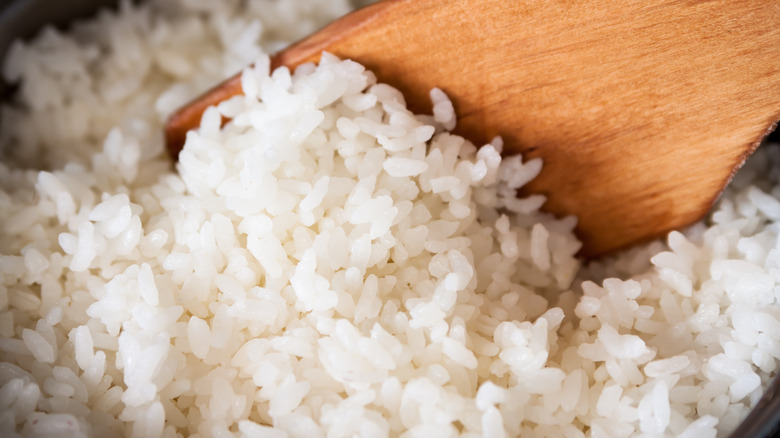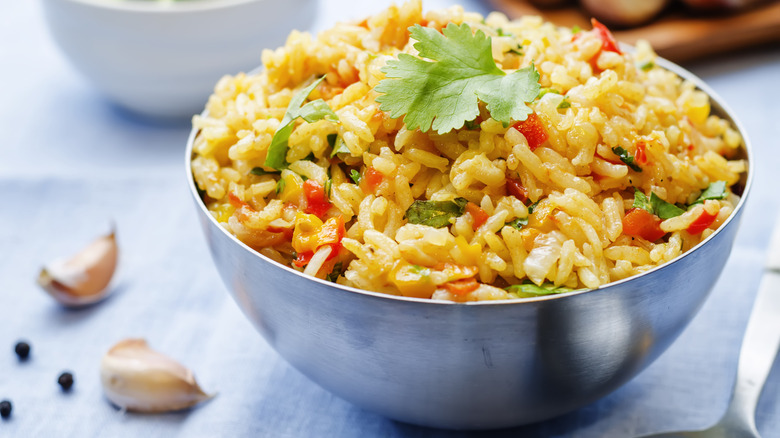Rachael Ray's Tip For Cooking Rice Without A Timer
Like most late-night gadgets you buy blurry-eyed from television (or a misleading dating profile), rice cooking is full of promise, but often disappoints. For such a simple dish, there are many ways to mess it up, making it feel risky to step away. Rather than babysitting the pot, Rachael Ray offers a helpful tip for cooking rice without a timer: use your senses.
Rice is temperamental, similar to cooking pasta. It requires a bit of trial and error to get the technique right. Following the manufacturer's instructions on the box can be helpful, but it's not enough to ensure that your rice will turn out perfectly every time. Instead, consider the directions a guide since they don't account for factors like the type of pot, stove performance, or water temperature.
@rachaelray Rice, rice baby...🍚 Never undercook or overcook your rice ever again 🙌 #fyp #rachaelray #learnontiktok #foryoupage #recipes #cooking
To prepare rice, Ray uses a saucepan with a clear lid, which allows her to monitor the water's evaporation. Just as stirring cooking rice is a one-way ticket to a disappointing texture, so is removing the lid once the water evaporates. When the rice is done, Ray recommends letting it rest undisturbed for about 10 minutes off the heat. This step allows the rice to finish cooking and absorb the moisture trapped in the pot, resulting in better texture and flavor. If your cookware doesn't have a clear lid, this method requires more trial until you get the timing right. But trust yourself, and resist peeking until the rice has rested.
Tips for making perfect rice
Unfortunately, once you perfect your cooking method for American long-grain white rice, you must adapt when you prepare a different rice type, change your cooking method, or even use a different pot. While all long-grain rices generally produce firm, separate grains that fluff up after cooking, the water-to-rice ratio and cooking times differ between various types, including brown and jasmine rice.
If you're looking for a foolproof way to get perfectly cooked grains and eliminate the risk of burning the pot, try cooking the rice like pasta. Start by rinsing the uncooked rice, as you typically would, while you boil a pot of salted water. There's no need to measure the water using this method; just cook the grains until they're al dente, tasting them a few times to check their texture. When al dente, drain the rice and return it to the pot to rest, as Rachael Ray recommends. Remove the lid after 10 minutes, and fluff the rice before serving. Like pasta water, don't throw away the starchy water from the rice; use it to thicken sauces and soups.
This method works best with long-grain rice types, since the rice's starches are drained away. Medium-grain rice, like Arborio (used for risotto) or short-grain sushi rice, needs its starch to produce the creamy texture we desire. Don't worry; we have a tip for that, too. To avoid constant stirring, try Ina Garten's method for oven risotto.
Ditch the water for more flavorful rice
Now that the cooking method has been simplified, we can discuss easy ways to make rice more flavorful. Without altering the liquid-to-rice ratio, you can impact its taste by adding pantry ingredients to the water, or swapping out the water entirely for a delicious alternative.
If water is the only liquid on hand, look to your spice collection for inspiration. Add bay leaves to the rice as it cooks for a fragrant upgrade, similar to how you might use thyme or oregano. Stick with dried, not fresh, bay leaves, which are more potent and less likely to taste bitter. For a fun alternative that reduces kitchen waste, try cooking the rice in pickle brine by substituting some cooking water with pickle juice. Don't worry; a ratio of two parts water to one part juice won't make your rice too tangy. Instead, the rice will be seasoned with the spices from your favorite pickle jar, like garlic, dill, or peppercorns. The brine's acidity will also brighten the dish. Since it's salty, hold off on adding additional salt.
When you're ready to completely replace the water, consider using low-sodium chicken broth, or coconut water to give the rice a tropical flair without the added fat of coconut milk. Coconut rice is a delicious side dish with Asian-inspired recipes and stir-fries. You can also experiment with the flavor by adding pantry items like sugar for a sweeter version, or curry powder.



